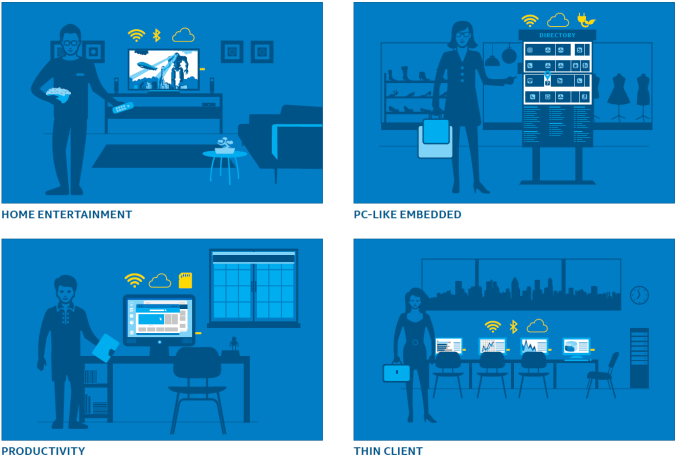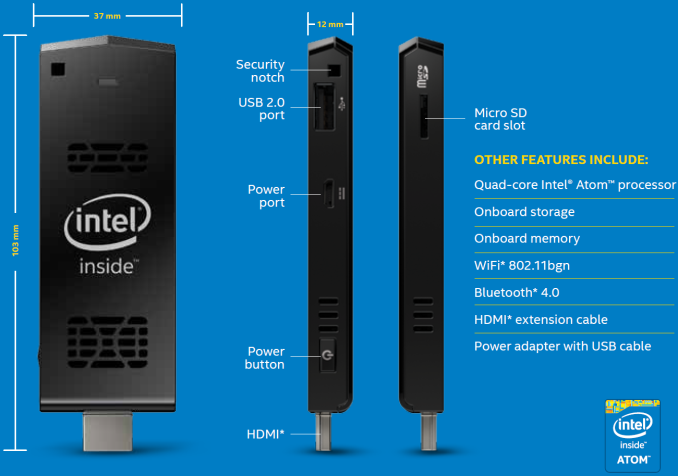Intel PPSTCK1A32WFC Bay Trail-T Compute Stick Review
by Ganesh T S on April 22, 2015 11:00 AM EST- Posted in
- Systems
- Intel
- Bay Trail
- HDMI Stick
Concluding Remarks
The Intel Compute Stick gave us the opportunity to see whether a tablet SoC could provide enough horsepower for a desktop PC. Based on our experience, the answer to that question is cautiously in the affirmative. There is no doubt that the device can do well as an economical solution for thin clients, kiosks and digital signage. These are scenarios where only one program runs for the life of the system and the OS is rarely updated.
The Compute Stick could do with some improvements for the scenarios in the left column
Traditional PCs have a different use-case compared to PC-like embedded systems and that brings us to the first problem in the Compute Stick we reviewed:
- OS drive size
32 GB, simply put, is just not enough after Windows installs a couple of updates. Out of the box, the system had around 17 GB free in the 23 GB disk (the rest, presumably, is the OS recovery partition). An initial update check resulted in a 1.3 GB download, and that installation brought down the free space to 14.3 GB. We have always been wary of Windows Updates on machines with low free space on the primary drive. As feared, attempting to install another round of updates resulted in a botched update problem (solved here). We had to spend 4+ hours getting the unit back to the initial state with a 'refresh' operation (and reinstall all the updates once again). To top it off, Windows lost activation in the refresh process and refused to reactivate (indicating a blacklisted key).
- Thermal design / solution
There is no doubt that the thermal design is very effective. Acoustic measurements come in at 28 dB at 1m distance. However, the irregular nature of the small-diameter fan makes for a strained experience if the user sits very close to the Compute Stick (possible in an office environment). It would not be a bad idea to go for a passively cooled Compute Stick at the cost of a slight increase in cost, weight and/or size.
- WLAN solution
The unit doesn't come with any wired networking facilities. It is essential that the Wi-Fi solution be top-notch. Unfortunately, a single-band 1x1 802.11n solution just doesn't cut it - particularly for scenarios involving video streaming. Thankfully, the presence of Bluetooth makes a USB keyboard / mouse unnecessary, freeing up the single USB 2.0 port for other purposes. Talking of video streaming, it would also be nice to have full HD audio support in the GPU drivers for Bay Trail-T (now that it has made its appearance in a mini-PC).
Despite the above shortcomings, the Compute Stick did impress us in a few areas - the form factor and portability aspects are praiseworthy. The CPU performance is not as bad as we feared it would be - Windows loads in a smooth manner and the system is as responsive as what one can expect from a Bay Trail-based mini-PC.
Coming to the business end of the review, we can say that the Intel Compute Stick is a typical first-generation product. In our opinion, there are way too many compromises being made to get to this form factor. There are certainly applications where the kit would be perfect, but general-purpose day-to-day computing is not one of them. If Intel wants the Compute Stick product line to take off like NUCs, addressing the three main shortcomings detailed above would be a good first step.












103 Comments
View All Comments
Refuge - Wednesday, April 22, 2015 - link
There are other reviews, that have not ran into any such problems installing the updates to the stick.So no, that isn't the case.
ganeshts - Wednesday, April 22, 2015 - link
Did they even mention whether they tried to do the update ? In any case, after the 'Refresh', I installed 1.3+ GB of updates all over again, and the second time went without a hitch. I think it depends on a lot of factors - eMMC behavior etc. , but, in general, it would be preferable to have plenty of free space on the primary drive for OSes such as Windows.BrokenCrayons - Wednesday, April 22, 2015 - link
Great review as always, but the Compute Stick isn't quite enough and it really doesn't have much to do with the CPU, but storage. The 32GB of storage problem has really been the biggest turn off of these kinds of small computing platforms. It'd work fine for most Linux distros, but Windows needs a good 16-32GB more, I think, before the device becomes flexible enough to use for things beyond very basic content consumption. I'd had hopes about Cherry Trail systems sticking around the same price point while offering a generational improvement in storage capacity, but with Intel's pricing, I have doubts that there'll be a sub-$150 device that ships with 2GB of RAM and 64GB solid state storage in the near term.Mr Perfect - Wednesday, April 22, 2015 - link
PPSTCK1A32WFC? Uhm, how much do you want to bet that people start calling it the peepee stick. I wonder if this was the marketing guys having a laugh, or if they honestly didn't think the name was questionable. It should be standard practice to run marketing material past a fifth-grader to see if they laugh(or me, apparently).BMNify - Wednesday, April 22, 2015 - link
Intel Compute Stick is the name of the product, looks pretty simple and self-explanatory to me, the detailed product code number is not marketed by anyone.biofishfreak - Wednesday, April 22, 2015 - link
Ganesh, do you know/ can you test if you can add this Compute Stick to a Windows domain?ganeshts - Wednesday, April 22, 2015 - link
It is running Win 8.1 with Bing - not Pro or Enterprise - as far as I can see, it is not possible to add this to a Windows domain.Kinemaxx - Wednesday, April 22, 2015 - link
So, the question that runs through my mind in every single one of these types of reviews, yet never seems to be given consideration: How well can these units play back Hi10p encoded h264 video? (either 720p or 1080p) Hi10p can't be GPU accelerated, so can they play video like that back at all, or will it be like watching a slideshow (as was the case on a friend's very early netbook)? I know Kodi is capable of playing back 10-bit video, so since they used Kodi in the test, it should certainly be testable.zeo - Monday, April 27, 2015 - link
Bay Trail is a good step up from the older Netbook ATOMs... 2-3x the performance... Chippy, from UMPCPortal, has a video demonstrating Hi10p playback. X.264 10-bit encoded file on a Bay Trail based Intel NUC... if you want to see how well Bay Trail handles such videos...Basically, Bay Trail's can usually handle Hi10p encoded videos, though, they can struggle a bit with 1080p Hi10P w/ FLAC audio... but it's watchable in most cases, depending on what you're watching and whether anything else is going on that also adds CPU load...
However, the SoC in this PC stick is on the lower end of the scale... So it may struggle a bit more and may require lowering expectations to 720P for smooth playback...
Twingo - Wednesday, April 22, 2015 - link
Price seems steep. You can get a tablet like the HP Stream 7 for < 100 dollars. Not sure why this would cost > 50% more when there is no battery or screen to drive up cost. If this were priced in the 70-80 dollar range that would make much more sense.